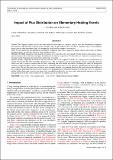Files in this item
Impact of flux distribution on elementary heating events
Item metadata
| dc.contributor.author | O'Hara, Jennifer Patricia | |
| dc.contributor.author | De Moortel, Ineke | |
| dc.date.accessioned | 2016-07-11T11:30:08Z | |
| dc.date.available | 2016-07-11T11:30:08Z | |
| dc.date.issued | 2016-10 | |
| dc.identifier | 244178800 | |
| dc.identifier | 041b4ed6-1d69-4de7-9ba7-0d414a1982b6 | |
| dc.identifier | 84991687635 | |
| dc.identifier | 000385832200098 | |
| dc.identifier.citation | O'Hara , J P & De Moortel , I 2016 , ' Impact of flux distribution on elementary heating events ' , Astronomy & Astrophysics , vol. 594 , A67 . https://doi.org/10.1051/0004-6361/201628913 | en |
| dc.identifier.issn | 1432-0746 | |
| dc.identifier.other | ORCID: /0000-0002-1452-9330/work/39526511 | |
| dc.identifier.uri | https://hdl.handle.net/10023/9109 | |
| dc.description | This work used the COSMA Data Centric system at Durham University, operated by the Institute for Computational Cosmology on behalf of the STFC DiRAC HPC Facility (www.dirac.ac.uk. This equipment was funded by a BIS National E-infrastructure capital grant ST/K00042X/1, STFC capital grant ST/K00087X/1, DiRAC Operations grant ST/K003267/1 and Durham University. DiRAC is part of the National E-Infrastructure. I.D.M was funded by the Science and Technology Facilities Council (UK). The research leading to these results has also received funding from the European Research Council (ERC) under the European Union Horizon 2020 research and innovation programme (grant agreement No. 647214). J.O was funded by the Science and Technology Facilities Council (UK) by Doctoral Grant [ST/K502327/1]. | en |
| dc.description.abstract | Context. The complex magnetic field on the solar surface has been shown to contain a range of sizes and distributions of magnetic flux structures. The dynamic evolution of this magnetic carpet by photospheric flows provides a continual source of free magnetic energy into the solar atmosphere, which can subsequently be released by magnetic reconnection. Aims. We investigate how the distribution and number of magnetic flux sources impact the energy release and locations of heating through magnetic reconnection driven by slow footpoint motions. Methods. 3D magnetohydrodynamic (MHD) simulations using Lare3D are carried out, where flux tubes are formed between positive and negative sources placed symmetrically on the lower and upper boundaries of the domain, respectively. The flux tubes are subjected to rotational driving velocities on the boundaries and are forced to interact and reconnect. Results. Initially, simple flux distributions with two and four sources are compared. In both cases, central current concentrations are formed between the flux tubes and Ohmic heating occurs. The reconnection and subsequent energy release is delayed in the four-source case and is shown to produce more locations of heating, but with smaller magnitudes. Increasing the values of the background field between the flux tubes is shown to delay the onset of reconnection and increases the efficiency of heating in both the two- and four-source cases. The cases with two flux tubes are always more energetic than the corresponding four flux tube cases, however the addition of the background field makes this disparity less significant. A final experiment with a larger number of smaller flux sources is considered and the field evolution and energetics are shown to be remarkably similar to the two-source case, indicating the importance of the size and separation of the flux sources relative to the spatial scales of the velocity driver. | |
| dc.format.extent | 18 | |
| dc.format.extent | 12922967 | |
| dc.language.iso | eng | |
| dc.relation.ispartof | Astronomy & Astrophysics | en |
| dc.subject | Sun: corona | en |
| dc.subject | Sun: magnetic fields | en |
| dc.subject | Sun: activity | en |
| dc.subject | Magnetohydrodynamics (MHD) | en |
| dc.subject | QB Astronomy | en |
| dc.subject | QC Physics | en |
| dc.subject | NDAS | en |
| dc.subject | BDC | en |
| dc.subject.lcc | QB | en |
| dc.subject.lcc | QC | en |
| dc.title | Impact of flux distribution on elementary heating events | en |
| dc.type | Journal article | en |
| dc.contributor.sponsor | European Research Council | en |
| dc.contributor.sponsor | Science & Technology Facilities Council | en |
| dc.contributor.institution | University of St Andrews. Applied Mathematics | en |
| dc.contributor.institution | University of St Andrews. School of Mathematics and Statistics | en |
| dc.identifier.doi | 10.1051/0004-6361/201628913 | |
| dc.description.status | Peer reviewed | en |
| dc.identifier.grantnumber | 647214 | en |
| dc.identifier.grantnumber | ST/N000609/1 | en |
This item appears in the following Collection(s)
Items in the St Andrews Research Repository are protected by copyright, with all rights reserved, unless otherwise indicated.

